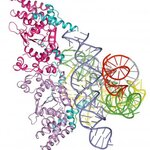Cancer Research

The crystal structure of a molecule from a primitive fungus has served as a time machine to show researchers more about the evolution of life from the simple to the complex.
By studying the three-dimensional version of the fungus protein bound to an RNA molecule, scientists from Purdue University and the University of Texas at Austin have been able to visualize how life progressed from an early self-replicating molecule that also performed chemical reactions to one in which proteins assumed some of the work.
"Now we can see how RNA progressed to share functions with proteins," said Alan…

Neurosurgeons from the University of California, San Francisco are reporting significant results of a new brain mapping technique that allows for the safe removal of tumors near language pathways in the brain. The technique minimizes brain exposure and reduces the amount of time a patient must be awake during surgery.
Perhaps even more profound, the study provides new data that refines scientists’ understanding of how language is organized within the human cortex. It identifies new regions involved in speech production, reading and naming. The team used this data to generate a three-…

That's the suggestion from a new UCLA study that tracked levels of cortisol, a key stress hormone, among 30 Los Angeles married couples involved in one of our age's trickiest juggling acts — raising kids when both parents work full time.
"At least as far as women are concerned, being happily married appears to bolster physiological recovery from work," said Darby E. Saxbe, the study's lead author and a UCLA graduate student in clinical psychology. "After a tough day at the office, cortisol levels dropped further among happily married women than less happily married ones. Less happily married…

A particular gene variation appears to significantly increase the risk that individuals with cirrhosis of the liver will go on to develop hepatocellular carcinoma (HCC), a liver tumor that is the third leading cause of cancer death.
In the January 2 Journal of the American Medical Association, researchers from Massachusetts General Hospital (MGH) Cancer Center and colleagues in France describe finding that a single alteration in the epidermal growth factor (EFG) gene may greatly increase the risk of developing HCC.
“If these results are confirmed, this EGF variation could be used to…

Older men with low testosterone levels who received testosterone supplementation increased lean body mass and decreased body fat, but were no stronger and had no improvement in mobility or cognition compared with men who did not use the supplement, according to a study in the January 2 issue of JAMA.
“Male aging is associated with a gradual but progressive decline in serum levels of testosterone, occurring to a greater extent in some men than in others. Decline in testosterone is associated with many symptoms and signs of aging such as a decrease in muscle mass and muscle strength, cognitive…

Children with cancer have a higher prevalence of body abnormalities, such as asymmetric lower limbs and curvature of the spine, suggesting that the genetic defect responsible for the abnormality may play a role in the development of cancer, according to a study in the January 2 issue of JAMA.
Certain genetic syndromes can be associated with an increased risk for tumor and cancer development in children. Several studies have shown that developmental genes, which play a role in body plan formation during embryogenesis, are also involved in the development of cancer, according to background…

Stem cells, popularly known as a source of biological rejuvenation, may play harmful roles in the body, specifically in the growth and spread of cancer. Amongst the wildly dividing cells of a tumor, scientists have located cancer stem cells. Physician-scientists from Weill Cornell Medical College are studying these cells with hopes of combating malignant cancers in the brain.
"Some patients' brain tumors respond to chemotherapy and some don't," says Dr. John A. Boockvar, the Alvina and Willis Murphy Assistant Professor of Neurological Surgery and head of the Brain Tumor Research Group at…

A research team at Weill Cornell Medical College in New York City has identified two genes that may be crucial to the production of an immune system cytokine called interleukin-10 (IL-10).
The discovery fills in an important "missing link" in a biochemical pathway that's long been tied to disorders ranging from lupus and Type 1 diabetes, to cancer and AIDS.
"IL-10 production has to be kept in a delicate balance for health," explains study senior researcher Dr. Xiaojing Ma, Professor of Immunology and Microbiology in the Departments of Microbiology and Immunology and Pediatrics at Weill…

Most people wouldn’t consider anthrax toxin to be beneficial, but this bacterial poison may someday be an effective cancer therapy. Anthrax toxin has actually been shown to be fairly selective in targeting melanoma cells, although the risk of non-cancer toxicity prevents any clinical use.
To develop a better and safer treatment, Stephen Leppla and colleagues created a mutated antrax toxin that could only be turned on by matrix metalloproteinases (MMP), proteins that are overproduced only in cancer cells.
When they tested this mutated toxin in mice, the researchers observed that 100% of the…

Over the course of the 20th Century, doctors waged war against infectious bacterial illness with the best new weapon they had: antibiotics.
But the emergence of dangerous, multi-drug resistant strains of tuberculosis and other killer infections means that in the 21st century antibiotics are losing ground against bacterial disease.
Now, researchers from Weill Cornell Medical College in New York City say exciting new molecular targets -- so-called "virulence factors" that bacteria use to thrive once they are in the host -- present an alternative, potent means of stopping TB, leprosy and other…